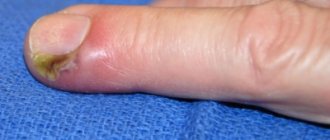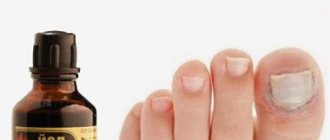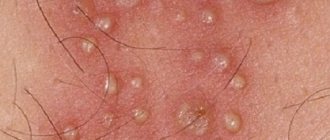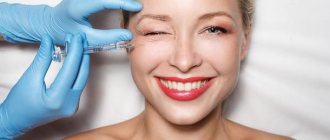A certain number of conditionally pathogenic fungal microorganisms are always present on the skin. They do not have a harmful effect on a relatively healthy person, and even protect the skin from the effects of bacteria. But under favorable conditions, the fungal colony begins to grow rapidly. The armpits are quite often affected by mycosis due to the presence of moisture in these areas. Let's take a closer look at what the armpit fungus looks like in the photo, why it appears and how to fight it.
Causes
Fungi of the genus Candida begin to multiply intensively with any destabilization of the acid balance and metabolism of the skin, leading to mycotic lesions of the armpits. Most often, activation of pathogenic microflora can be triggered by:
- Hormone imbalances during puberty, pregnancy or menopause.
- Stressful situations that cause deterioration of immunity and increased activity of sweat glands.
- Metabolic disorders (hyperthyroidism and diabetes mellitus).
- Hereditary predisposition to hyperhidrosis and mycoses.
- Chronic somatic and infectious diseases in children and adults.
- Obesity or overweight. An optimal environment for the development of fungus is created in the skin folds.
- Neglect of personal hygiene rules.
In addition, you can become infected by frequent visits to public saunas, baths, and swimming pools, since there are favorable conditions for active growth of the fungus. It is advisable to avoid such places if there are doubts about their cleanliness or the room smells of mold.
Treatment
Therapeutic measures should be prescribed by a specialist dermatologist, since here it is necessary to remember that the axillary zone is a favorable environment for the development of pathology, and also that pathology spreads quickly and is difficult to eliminate.
Self-medication is dangerous with complications!
Attention
Despite the fact that our articles are based on trusted sources and have been tested by practicing doctors, the same symptoms can be signs of different diseases, and the disease may not proceed according to the textbook.
Pros of seeing a doctor:
- Only a specialist will prescribe suitable medications.
- Recovery will be easier and faster.
- The doctor will monitor the course of the disease and help avoid complications.
find a doctor
Do not try to treat yourself - consult a specialist.
Initial therapy stops the spread of the lesion to healthy areas.
Before deciding on treatment, the dermatologist determines the extent and area of the lesion. The doctor prescribes medications that strengthen the immune system and dry out the lesions.
Medications
The therapy is prescribed in a comprehensive manner, and it is aimed not only at eliminating the symptoms, but also at the causes of their occurrence; for this, the following measures must be taken:
- If the protective barrier is weakened the immune system ; immunostimulants and vitamin complexes must be prescribed.
- When the sweat glands work hard, it is necessary to take medications to eliminate hyperhidrosis.
- Symptomatic therapy - for this, ointments, creams, sprays are prescribed, which have a drying effect, anti-inflammatory and healing effect. Blocks the development of fungus.
- Prevention measures - if the body is prone to developing a fungal disease, it is recommended to carry out hardening measures, strengthening the immune system, switching to a healthy diet, and normalizing the functioning of the sweat glands.
Application of ointments
Without the use of local treatment, getting rid of fungal infection is impossible. For this purpose, various ointments, creams and sprays with a drying effect are used. Prescription of medications occurs individually, based on the degree of pathology, anatomical features of the skin and other factors. But in any case, it is necessary to prescribe antifungal agents that eliminate fungal diseases.
Symptoms
A distinctive sign of the fungus is the appearance of diaper rash under the arms, hyperemia and a characteristic white coating in the area of the outbreak.
Usually armpit fungus is accompanied by:
- peeling,
- the appearance of a whitish flour-like coating,
- painful itching,
- painful cracks.
Mycosis should be differentiated from lichen. Both diseases have a similar pathogenesis and clinical picture, however, with lichen, red spots appear on the skin of the armpits, gradually becoming covered with a brownish crust. The rash may be itchy and dry and flaky.
Which doctor should I contact?
The fungus under the arms will not go away if you do not start treating it. The patient’s attending physician will tell the patient which ointments and other medications to use for this form of mycosis. With such problems, you should first contact a dermatologist, as he specializes in skin diseases. If such a need arises, he will refer the patient who came for an appointment to another highly specialized specialist for additional consultation. Usually, if you have a fungus, you are sent to a gynecologist, therapist or venereologist. It all depends on the form of the pathology.
No preparation is required before visiting a doctor. It is recommended to refrain from using deodorant. It is best to simply wash your armpits thoroughly with regular soap. If there is dense vegetation in this area, you will have to get rid of it, as it will prevent the specialist from conducting a full inspection of the contaminated area.
Diagnostics
The simplest method for determining the cause of redness and itching in the armpit area is the Balzar test . It is necessary to treat the affected area with a 2% solution of aniline dyes. If diaper rash is caused by a fungus, the skin at the site where the dye is applied will acquire a rich shade.
To accurately determine the type of pathogen, the possible addition of a secondary infection and prescribe adequate treatment, you should undergo a biochemical blood test and bacterial culture. As a primary diagnosis, irradiation of the affected areas with mercury-quartz lamps is used, which allows visualization of fungal colonies.
Possible complications
This disease is dangerous because the fungus is resistant to various factors and is characterized by rapid damage to new areas.
Since patients constantly experience itching, wounds form at the affected areas due to constant scratching, through which pathogens and infections can enter the body. Therefore, a disease such as a fungus requires mandatory and timely treatment.
Often, when scratching, purulent formations appear, which subsequently open. Without therapy, recovery is delayed and will require more time and effort. If the patient receives the necessary help, the abscess heals quickly.
Prevention methods
To reduce the risk of fungal infection of the armpits, it is advisable to adhere to the following rules:
- To reduce sweating, you need to wear clothes mainly made from natural fabrics.
- Maintain personal hygiene, take a shower at least 2 times a day.
- During the off-season, use products that enhance immunity (vitamins, immunostimulants, microelements).
- Spend more time outdoors, dress appropriately for the weather.
- Hardening and dousing with water helps reduce excessive sweating.
For severe sweating, current therapy and laser correction that block the sweat glands are recommended. Long-acting antiperspirants should be used as a preventative measure.
How to treat armpit fungus
As a therapy, adults, on the recommendation of a doctor, can use local and systemic drugs against fungus under the armpit. A dermatologist will be able to tell which products to use only after studying the results of the patient’s studies.
Medicines
For a fungal disease under the armpits, the doctor prescribes medications
Mycoses are usually treated with ointments and tablets. They are fought with the help of gel. Recovery from a fungal infection can be facilitated by a special cream and a group of other products intended for external or internal use. Ointment for underarm fungus must be approved by your doctor. Otherwise, the patient cannot be confident in the safety of such therapy.
Read also: Bifonazole: features, indications, release forms, instructions for use and contraindications
The most popular treatments for fungus in the armpits are local medications. They are prescribed based on information about which pathogen has developed active activity on the patient’s body. Its sensitivity to certain active substances is also taken into account.
When conducting local therapy, a specialist may recommend the patient to use the following medications for external application:
- "Lamisil." The first results appear on the 3rd day of treatment. It copes with fungal pathogens of many types,
- "Terbizil." Negatively affects the structure of the pores of the fungus, and also fights signs of the inflammatory process,
- "Atifin". The medication is often used as one part of a complex treatment,
- "Clotrimazole". Destroys fungal spore structures and destroys mycelium,
- "Terbinafine". Helps get rid of discomfort caused by fungus,
- "Fungotherbin." The product suppresses the activity of pathogenic microorganisms.
Topical medications with antifungal properties are found in different price categories. Therefore, each patient can choose a medicine at an affordable price.
It is also recommended to use budget ointments against fungus - zinc and salicylic. They are best used as compresses under the armpits to speed up the recovery of tissues affected in this area.
Patients are not always able to cure fungus in the armpit area with local medications alone. In this case, systemic remedies help them get rid of the disease. Their active components have a detrimental effect on pathogenic microflora from inside the human body.
The following systemic medications help cope with the disease:
- "Fluconazole"
- "Itraconazole"
- "Ketoconazole"
- "Mikozan."
Taking systemic medications with antifungal action must be carried out in accordance with the instructions for their use. It is strongly recommended that you strictly adhere to the dosage of the medication prescribed by your doctor in order to prevent the occurrence of side effects and signs of overdose.
Folk remedies
Herbal infusions are very effective in eliminating fungal infections
Treatment of armpit fungus with traditional drugs can be combined with folk remedies if they are approved by the attending physician. At the initial stage of infection, they give a good result, namely, they stop the development of the disease and reduce the severity of its symptoms.
Read also: Tinidazole: features of action, indications for use, route of administration and dosage, contraindications and drug interactions
For fungal infections under the armpits, it is recommended to use the following folk remedies:
- Buckwheat with calendula. You need to pour 300 ml of water into 50 g of cereal, then boil it. Next, you need to drain the liquid and add 20 drops of calendula tincture with alcohol. It is recommended to wipe the infected areas with the resulting solution,
- St. John's wort oil with Vaseline. These ingredients must be mixed together in equal proportions. Afterwards, the resulting mixture should be applied to problem areas affected by fungus in a thin layer. After 15 minutes, you can rinse your armpits with cool or warm water. It is advisable to carry out this procedure 2-3 times a day,
- Burdock with chamomile. 50 g of each component must be mixed, then pour in 0.5 liters of water. The whole mass needs to be simmered over low heat for 35 minutes. Next, the remedy should be cooled and strained. Use it to regularly treat infected areas,
- A collection of horsetail, oak bark, birch buds, walnut leaves and pine branches. From these components, according to a standard recipe, decoctions and tinctures are prepared, which the patient will need to carry out a hygienic procedure.
The folk remedy can be used before or after the drug for external use.
Is it possible to become infected through household items and clothing?
There is an opinion that the fungus can be infected through household items: shared bedding, dishes, shoes, clothes, towels. This opinion is only partly true: even if mycotic spores get on the skin of a healthy person, this does not necessarily guarantee the appearance of spots, itching, or peeling.
As mentioned above, spores of mycotic infections can be found on the skin of almost any person. But they are activated only if the body and immunity are so weak that they are unable to stop the process.
Vitamin and mineral complexes for skin
As mentioned above, fungal skin lesions should be treated comprehensively. Taking vitamin-mineral complexes is a simple way to avoid deficiencies of vital microelements. Below is a list of complexes, the use of which will allow you to achieve the fastest possible healing of the skin and return it to its original form:
- "Perfectil" contains minerals, vitamins, as well as plant extracts, the presence of which in the composition contributes to the rapid restoration of the epidermis. While taking it, immunity will increase and hair loss will stop (due to the zinc content in the composition).
- “Brewer's Yeast Esvitsin” contains faith and a full complex of B vitamins, due to which it can quickly restore the skin.
- "Pantovigar" - vitamins containing brewer's yeast, promote regeneration and improve the protective properties of the epidermis.











